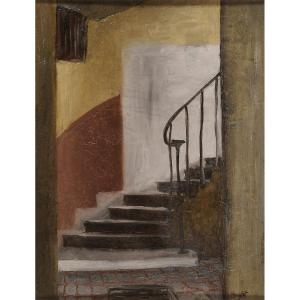(Utrecht 1601/02 – Utrecht 1672)
Venus and Cupid
Oil on panel
H. 75 cm; W. 61 cm
Signed and dated 1636
Hendrick Bloemaert is a notable figure of the Golden Age of Dutch painting, although his work is often overshadowed by that of his more famous contemporaries. Son of the Mannerist painter Abraham Bloemaert, Hendrick grew up in a rich and stimulating artistic environment, which undoubtedly influenced his own creative journey. He distinguished himself by remarkable technical mastery and a refined aesthetic sensibility. His works, often marked by great precision in the rendering of details and a subtle chromatic palette, demonstrate a constant search for harmony and balance. He excelled in various pictorial genres, ranging from mythological scenes to portraits, the figure being his preferred domain. His style, although deeply rooted in the Mannerist tradition inherited from his father, also shows influences from Classicism and Baroque, which gives his compositions a particular richness and complexity. Hendrick Bloemaert was able to integrate these different influences to create a unique visual language, where grace and rigor combine harmoniously.
Our panel dated 1636 depicts Venus, goddess of love, and Cupid, her winged son. They are central figures in Roman mythology. Cupid, armed with arrows, provokes love or indifference while Venus symbolizes beauty and seduction. They are often depicted together, illustrating the themes of love and desire. Their mother-son relationship is imbued with tenderness and complicity, inspiring many works like ours. Here, Venus turns her back, with one shoulder bare, to the viewer, looking to the right of the plane, as if she disdains the admiration that might be felt for her. Cupid is positioned in front of us, half in the shadows, his face slightly tilted in the most touching way possible.








































 Le Magazine de PROANTIC
Le Magazine de PROANTIC TRÉSORS Magazine
TRÉSORS Magazine Rivista Artiquariato
Rivista Artiquariato